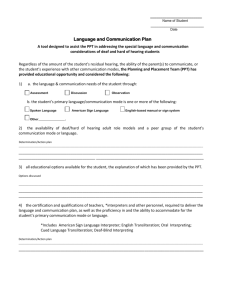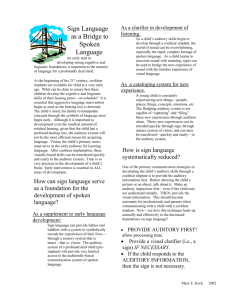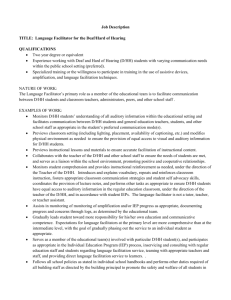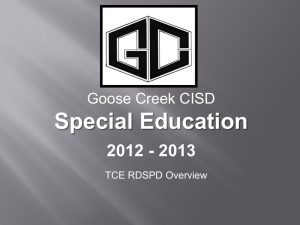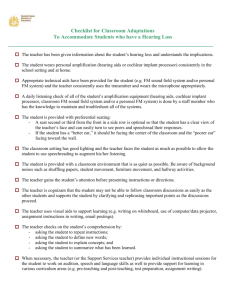To Develop Spoken Language in Infants-
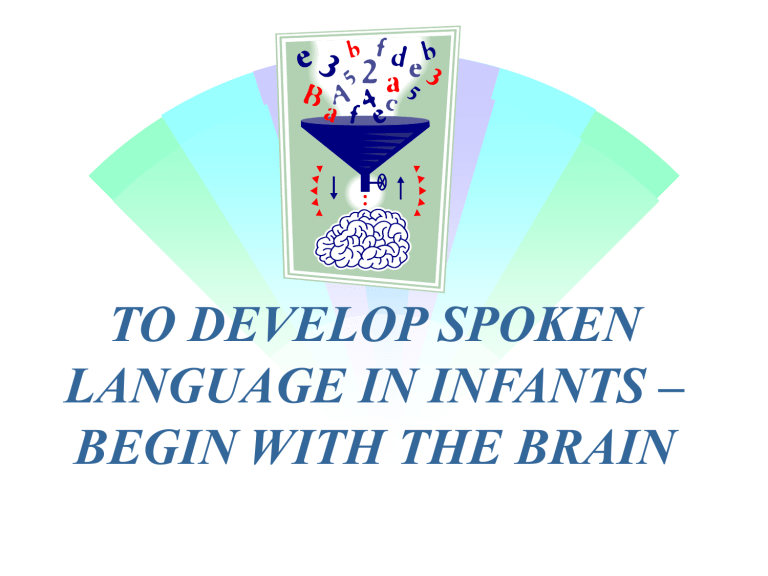
TO DEVELOP SPOKEN
LANGUAGE IN INFANTS –
BEGIN WITH THE BRAIN
CAROL FLEXER, PH.D.
DISTINGUISHED PROFESSOR OF
AUDIOLOGY
NORTHEAST OHIO AU.D.
CONSORTIUM (NOAC)
SCHOOL OF SPEECH-LANGUAGE
PATHOLOGY AND AUDIOLOGY
THE UNIVERSITY OF AKRON
AKRON, OHIO 44325
THEMES
Hearing is a first-order event for the development of spoken communication and literacy skills.
Anytime the word “hearing” is used, think
“ auditory brain development
”!!
Acoustic accessibility of intelligible speech is essential for brain growth.
Signal-to-Noise Ratio is the key to hearing intelligible speech.
Our early intervention protocols and classroom environments must take into consideration the listening capabilities and limitations of ALL children .
IT’S ALL ABOUT THE
BRAIN
Hearing loss is not about the ears; it’s about the brain!
Hearing aids, FM systems and cochlear implants are not about the ears; they are about the brain!
NEUROLOGICAL ISSUES
We hear with the brain -- the ears are just a way in! What’s the big deal?
Hearing loss keeps sound from reaching the brain.
Human beings are rich in auditory brain tissue –
But children can’t listen like adults!
Why?
1) the higher auditory brain centers are not fully developed until a child is about 15 years old,
2) and children cannot perform sophisticated
“automatic auditory cognitive closure”.
Therefore, all infants and children need a quieter environment and a louder signal than adults.
Auditory Neural Activity
Important changes have been shown in the higher auditory centers due to deafness.
The auditory cortex is directly involved in speech perception and language processing in humans (Kretzmer ie al, 2004).
Normal maturation of central auditory pathways is a precondition for the normal development of speech and language skills in children (Sharma et. Al, 2004).
Auditory Neural Activity
(Sharma et al, 2004)
Data suggest that children receiving implants very early (around 1 year of age) may benefit from relatively greater plasticity of the auditory pathways than children with implantation later within the developmentally sensitive period.
Their results suggest that rapid changes in P1 latencies and changes in response morphology are not unique to electrical stimulation but rather reflect the response of a deprived sensory system to new stimulation.
Data suggest that the development of early communication behaviors following implantation may be promoted by changes in central auditory pathways.
Summary of Neuroplasticity
Greatest in the first 3 ½ years of life
The younger the infant, the greater the neuroplasticity
Rapid infant brain growth requires prompt intervention, typically including amplification or cochlear implants, and a program to promote auditory skill development.
Therefore, identification of newborn hearing loss should be considered a neurodevelopmental emergency.
Early Intervention Outcomes
Emerging data are showing that over 90% of children born with a profound hearing loss who obtain a cochlear implant before they are 2, attain intelligible speech.
This outcome also is based on having the cochlear implant mapped appropriately and worn consistently.
Direct, repetitive auditory skill instruction as part of an effective early intervention program, also is critical. That is, “extra” auditory stimulation is necessary.
Outcomes
Data show that only about 20% of children born with a profound hearing loss who wear hearing aids (and not a cochlear implant), attain intelligible speech.
Data also show that about 80% of children born with a profound hearing loss who have a cochlear implant inserted between 2 years and 4 years of age, attain intelligible speech
(with appropriate intervention).
Why Early ID and Implantation, before age 2, is Critical (Robbins, et. al, 2004)
Skills mastered as close as possible to the time that a child is biologically intended to do so, results in
developmental synchrony.
Mastery of any developmental skill depends on
cumulative practice: the more delayed the age of acquisition of a skill, the farther behind children are in the amount of cumulative practice they have had to perfect that skill. The same concept holds true for cumulative auditory practice.
Delayed auditory development leads to delayed language skills.
THE BIG PICTURE: THE
WORLD HAS CHANGED!
Who Moved my Cheese?
by Spencer
Johnson, M.D. – a book about change
We have Information/Knowledge-based economies that demand high levels of spoken communication and literacy.
We are educating children to take charge in the world of 2030, 2040, and 2050….not in the world of 1970 or 1990 or even 2005.
KEY STUDY BY HART AND
RISLEY
Meaningful Differences in the
Everyday Experience of Young
American Children
THE WORLD HAS CHANGED FOR
HEARING LOSS, TOO.
SPOKEN COMMUNICATION: PAST
AND PRESENT
(1)Audiotape of possible auditory-oral outcomes before early identification, early intervention, and cochlear implant technology – and (2)videotape of possible auditory-verbal outcomes in this day and age.
Video of Julia
Born profoundly deaf
age at CI: 18 months
Nucleus 22 - SPEAK
chronological age - 7 years (at recording)
auditory brain development age - 5
1/2 years (at recording)
intervention strategy -
Auditory-Verbal
DEFINITIONS: NEW
DISTINCTIONS FOR THE
WORDS DEAF AND HARD OF
HEARING TO EXPRESS
NEUROPLASTIC
POSSIBILITIES
Distinguish Audiometric and
Functional Definitions for:
Hard of Hearing
Deaf
Hearing Impaired
This is a way to reflect the changing world
Audiometric Definitions: Hard of Hearing
Unaided audiometric thresholds (PTA - Pure
Tone Average) are better than 70 dBHL.
The brain has some access to sound even when the child is not amplified.
Audiometric Definitions: Deaf
Unaided audiometric thresholds (PTA - Pure
Tone Average) are worse than 70 dBHL.
The brain has virtually no access to sound when the child is not amplified.
Functional definitions: Hard of
Hearing
Describes a person who learned language primarily auditorally and who receives information from the environment primarily auditorally -- no matter what the degree of hearing loss or time of onset of the hearing loss.
A child who is functionally hard of hearing has a
“hearing brain”, even though she might be audiometrically deaf.
Functional definitions: Deaf
Describes a person who learned language primarily visually (lip-reading, cued speech manual communication, communication board), and who receives information from the environment primarily visually.
Functional definitions: Hearing
Impaired
Describes any type and degree of hearing loss, no matter what the cause, degree, type or time of onset.
Implications of Functional
Definitions:
Children who are functionally hard of hearing are much more like persons with typical hearing - regarding how they learn and which neurological centers of the brain are stimulated - than they are like someone who is functionally deaf.
In this day and age, audiometric definitions should not determine
functional outcomes.
Implications of Functional
Definitions:
Do not group children who are functionally hard of hearing with children who are functionally deaf -- they are not the same populations.
A goal of amplification technology followed by auditory-based intervention is to enable children with all degrees of hearing loss to be functionally hard of hearing.
Implications of Functional
Definitions:
With early identification, advanced hearing aids, FM, and cochlear implant technologies and our current knowledge of child development and brain function, children who are audiometrically deaf can be primarily auditory.
The indicated treatment and appropriate technologies relate to the desired outcomes expressed by the family.
Implications of Functional
Definitions:
The nature, quality and integrity of the audiologic management that a child receives from the onset, is probably the most important factor in determining if a child will be functionally hard of hearing or functionally deaf.
Paradigm Shift
What I’m talking about is a paradigm shift in the way we view and manage hearing loss-- from using technology to create a visual world, to using technology to create an accessible auditory world for children with hearing loss.
The “Cheese has Moved” regarding our views of deafness in the new millennium.
WAYS TO DEAL WITH
SHIFTING PARADIGMS
Keep the old paradigm – Change “customers”
Change the paradigm – Keep the customers
Change the paradigm – Change the customers
“Neglect the future, and no one will thank you for managing the present”.
HOW TO “GROW” YOUR
CHILD’S BRAIN
Information to share with families of children with hearing problems of any type and degree, including auditory processing difficulties
FOR PARENTS: HOW TO GROW
AUDITORY BRAIN CENTERS
Above all, love, play, and have fun with your child!
Once your child receives a hearing aid or cochlear implant, make sure he/she wears it every waking hour. The auditory brain centers need consistent access to clear, complete sound in order to develop.
Check your child’s technology regularly.
Equipment malfunctions, often.
FOR PARENTS: HOW TO GROW
AUDITORY BRAIN CENTERS
Minimize background noise . Turn off the
T.V.
Sing to your child! Fill their days with all kinds of music and songs.
Speak in full sentences. Pronounce words clearly, with lots of melody. Stay close!
Focus your child on listening . Call attention to sounds around the room. Point to your ear. Use listening words such as “you heard that”, and “you were listening”.
Emphasize sound before vision for auditory enrichment.
FOR PARENTS: HOW TO GROW
AUDITORY BRAIN CENTERS
Read aloud every day. Try for 10 books per day.
Name objects in the environment as you encounter them in daily routines.
Talk about and describe how things sound, look, and feel.
Compare how objects or actions are similar and different in size, shape, smell, color, or texture.
FOR PARENTS: HOW TO GROW
AUDITORY BRAIN CENTERS
Talk about where objects are located.
You will use many prepositions such as in, on, under, behind, beside, next to, between.
Prepositions are the bridge between concrete and abstract thinking.
Describe sequences . Talk about the steps involved in activities as you are doing the activity. Sequencing is necessary for organization.
If the parent’s goal is to teach spoken language to their baby…..
There needs to be a pediatric/educational audiologist committed to every early intervention program!
Early identification and technological management is essential to take advantage of brain neuroplasticity.
Infants and children need focused and intentional auditorybased input:
• hearing aids, and/or implant must be worn at all times
• therapy must emphasize audition/auditory brain access and development.
RESOURCES
Archives of Otolaryngology – Head and Neck
Surgery.
May 2004.
Flexer, C. (1999). Facilitating Hearing and
Listening in Young Children, 2 nd ed . San Diego:
Singular Publishing Group.
Roberston. L. (2000). Literacy Learning for
Children Who are Deaf or Hard of Hearing.
Washington DC: Alexander Graham Bell
Association for the Deaf and Hard of Hearing.
WEB SITES
www.audiology.org
www.agbell.org
www.oraldeafed.org
www.auditoryverbal.org
www.nciohio.com
www.auditoryoptions
.org
THE PROJECT: EXPANDING
EARLY INTERVENTION
RESOURCES FOR AUDITORY-
BASED SERVICES
This project is designed to provide information, resources, and support for families who have spoken language as a desired outcome for their infant or toddler.
It’s a state-wide auditory initiative in Ohio.
www.auditoryoptions.org
Purpose of the Auditory-Options
Project
The Project’s purpose is to develop, promote and provide auditory-based methodologies for infants, toddlers and preschoolers who are deaf or hard of hearing within the framework of existing state operated early intervention programs.
The family’s right of choice is paramount and will always be respected.
Services and materials are provided only if requested by the family and service provider.
Project Services & Resources
Offered Upon Request
Free in-services for professionals
Free materials/resources, following inservices, for groups
& individuals providing direct auditory- based interventions
Free direct consultations, training and therapy demonstrations for families & professionals, from a full-time staff member who lives in
Columbus and will travel around the state.
Free parent mentor services from two oral deaf adults and
12 parents located around the state, who have lived and breathed the ‘auditory’ lifestyle
BRAIN, BRAIN, BRAIN!!!
The purpose of hearing aids, cochlear implants, personal-worn FM, classroom FM and IR systems, and auditory-based intervention is to access, grow and develop auditory brain centers.


